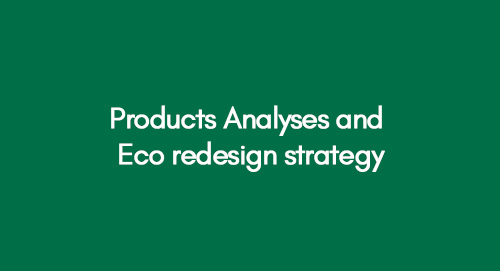
Entrepreneurial skills
January 28, 2021
Analyze and evaluate the impacts of Water surface Roughness and friction on open channel shallow water flow
January 28, 2021Product analyses are the crucible where innovation meets introspection in the alchemy of progress. Eco Redesign Strategy becomes the philosopher's stone, transforming consumer aspirations into sustainable, harmonious solutions for a planet needing renewal.
Outline
- Background and Introduction
- Products Analyses and Eco Redesign Strategy
- Assumptions and Calculations
- Conclusion
- References
Product analysis explores how items are made and used, while an eco-redesign strategy focuses on making products more environmentally friendly. Together, they aim to improve sustainability and reduce environmental impact.
Background and Introduction
Consideration of environmental impacts and overall energy consumption of the finished products can help the designers come up with greener equipment designs. During the early stages of the product design, the complete Life Cycle Analysis may not be feasible but following the basic environmental principles, however, it can lead to more economically viable products.
Figure More about Importance of Products Analyses and Eco Redesign Strategy Here
To demonstrate the importance of sustainable design in today’s world, the design of a kettle has been discussed in this report. The kettle is an electro-mechanical product that produces hot water via consuming electricity. Author Chris Goodall in his book ‘’How to Live a Low-Carbon Life: The Individual's Guide to Stopping Climate Change’’ estimated that household kettles produce up to 4 percent of the Household carbon emissions in the UK (Sherwin, 2012). Considering the impact of this huge figure, even small and smart changes in the design of this product can do wonders to the environment
Studying products helps us understand how they're made and used. Eco-redesign is about making things greener to help the planet.
Products Analyses and Eco Redesign Strategy
During the kettle’s operation, most of the energy is consumed by boiling water. Typically, much of this energy is lost by inefficient user behaviour such as overfilling with respect to the required value, overheating, and multiple heating and using hard water. Most of these issues can be addressed using innovations and tackling user behaviour with smart designs.
Many kettles are now available in the market that offers smart and sustainable design options. Through reliable and durable kettle designs have been selected to assess their environmental impacts and energy consumption/efficiency functions, a summary of which is shown in Table 1 below;
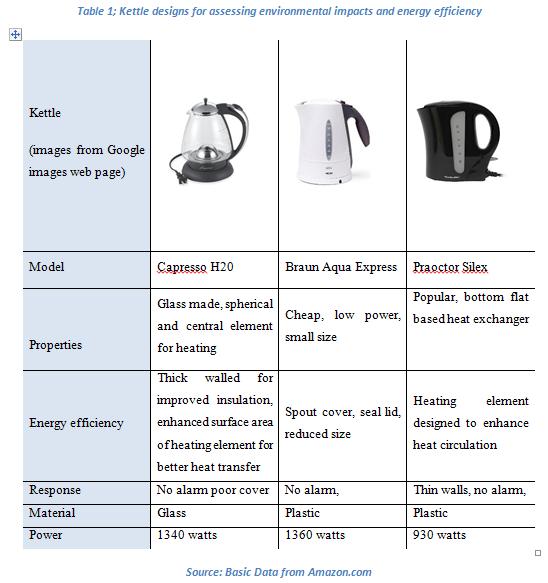
Assessing the usage patterns of these models, the following are the design aspects where improvements can be made for enhanced sustainability;
- Optimized use of kettle power shut off at the required temperature set point; it would minimize the time delay between boiling and shut-off and hence reduce energy consumption
- Clear and noticeable signal to the user that the water has reached its set point; reduced and or eliminate energy lost on instances where the user forgets to consume the heated water on time and re-heat the water
- Energy can be saved through efficient insulation and heating systems and by reducing the energy lost through the steam
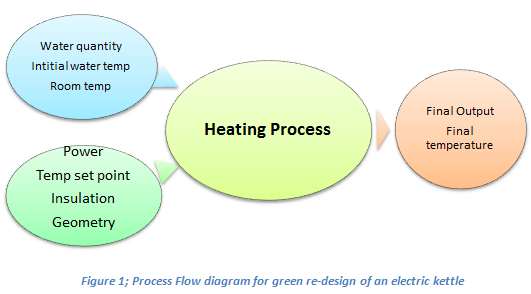
Concepts Creation and Design Considerations
Since temperature is found to be the dominant factor in the process flow diagram (Figure 1), instruments like the thermometers/thermocouples and bimetallic strips were added to the list of different techniques to measure temperature that was created as part of the concept generation process. Another list, detailing the techniques for notifying the user of the unexpected shutoff, was also created. This included tools for seeing, hearing and smelling.
The design of the kettle can be improved considerably by controlling the factors such as the start and stop temperature and the amount of water inside the kettle. It should be noted that not all the design concepts are viable and therefore ideas such as using gravity to assist the boiling water in a locked kettle were found to be infeasible for several reasons including safety and energy loss (Zimmerman, et al., 2003).
Optimized Rate and Duration to Minimize the Number of Resources Used
The concept generation method in the previous section determined the features that can play a big part in the green redesign of the electric kettle. Figure 2 shows the features and design improvements that can be employed for the electric kettle.
A reduction in the final temperature of the water can considerably decrease energy consumption. The final temperature of the water can be lowered only if the amount of energy transferred to it is lowered.
Regardless of what type of kettle is under consideration, energy lost to the environment is significant at high temperatures. Energy is mainly lost to conduction, conduction and radiation mechanisms. Energy loss to the environment can also be controlled by increasing the power supply (Karna, 2002). The duration of heat transfer to the environment can be reduced significantly by heating the water more quickly.
A large number of products use this application to maximize efficiency levels whilst reducing the amount of heat transferred to the environment. Low flow shower heads, washing machines and advanced tanks with fewer water heaters are some of the most commonly used examples By heating the water at a time when the tank is lessened, tank fewer water heaters can save a considerable amount of energy (Telenko, et al., 2009). Maintaining the water temperature, on the other hand, needs more power input and hence there is more chance of energy being wasted.
High spin washing machines are also recommended to be used instead of ordinary washing machines to purge more water from clothing. Similarly, public showers can be shut off at selected intervals to conserve energy. By doing so, water will only be used when needed. Studies have shown that such equipment use at least 28 percent less energy than its counterparts. Considering the above examples, it will be safe to say that this technology can be applied to a variety of products.
Using Manual and Automatic Tuning Capabilities
The duration of water heating can be further reduced by using manual or automatic tuning abilities. This can be done by allowing the user to set the desired water temperature. Therefore, if the observer sees the water boiling at 90 degrees C, the equipment can be turned off, thereby limiting the duration of heating. Further reduction in the heating duration can be achieved by allowing the user to set the stopping temperature. For example, if the user knows the water is going to boil at 90 degrees C, he can set the stopping temperature to this value. A number of products including programmable thermostats, some washing and drying systems and multi-flush toilets use this application (Tomlison and Durfee, 2001). Studies have shown that up to 60 percent energy savings in washing machines and dryers can be made by providing manual and automatic settings.
Feedback systems are also an important aspect in the redesign of an electric kettle. This mechanism informs the users of the current status of the heating process or the temperature value. By preventing unnecessary water heating, further reduction in heating duration is possible. The feedback system will also help the user end the heating process when the required temperature value is achieved. Many types of products including ovens use this application successfully to save energy. Almost all new ovens are fitted with a reading meter or alarms to notify the users so they can end the heating process instantly.
Separate Modules Performing Different Tasks
Based on the idea that electric hybrid vehicles use an electric motor and a gasoline engine separately to maximize efficiency, the segment for measuring water in the electric kettle is separated from the water heating section. EcoKettle is a classic example of this application as it uses this method to maximize the output levels. EcoKettle is designed with two separate segments; one for heating water and the other one for storage as shown in figure 2 below. By applying this technique, users can store as much as water they want in the kettle without heating more than what is required.
Figure 2: EcoKettle design
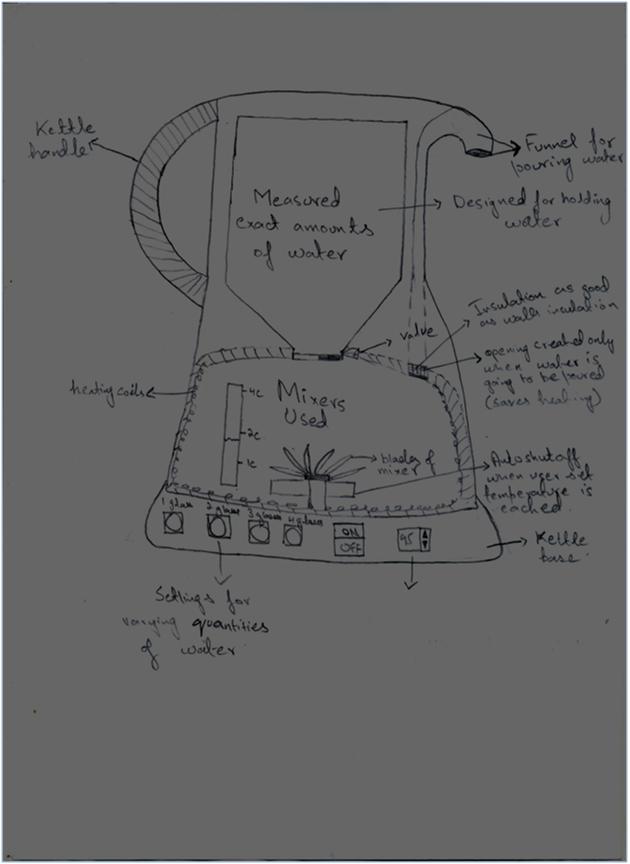
Materials (M) | Energy (E) | Toxic Emissions (T) | |
Raw material attainment | 1200 g (approx) | Transport energy for importing up to 16 different materials mercury | Mercury disposal and chlorinated waste disposal in water during PVC production |
Production of eproduct | assembly | Assembly completed through compressed air (negligible energy consumption per kettle) Kettle testing: 0.06 Mj | N/A |
Distribution | Packaging for sales; Cardboard 500 g, Paper 10gpolyethenene 11 g Transport through wood box | Transported via truck to the retailers with an average distance of travel estimated as 200km, consuming diesel as the duel type. | Transport emissions including Oxides of Carbon, Oxides of Nitrogen and other |
Use utilization estimated | Estimated consumption of water during 4 years of operation; 1280 litre variable | Variable. Average use may be 8 times per week. The energy required to heat per lire ~0.350 Mj | Solid waste (landfill) and emission to water and air during energy production (energy that is consumed by the product) |
Disposal/end of life | N/A | Landfill transport truck currently | Currently disposed of in landfill. Much of the cardboard packaging is recycled |
Quantitative LCA Analyses, and EcoWheel Diagram; Investigating Real-life Environmental Impacts
Small changes as discussed in the design considerations can have an influential effect on the environment; however, no useful data has been published in detail in this regard. An effort has been made to estimate the environmental impact of changes made in the new design, which has been described in the following table 2.
Table 2; New LCA analyses with respect to system performance
1 | 2 | 3 | 4 | |
Guideline | Optimising the rate and time to minimise the quantity of resources used | Using manual and automatic tuning capabilities | Feedback systems to inform users of the current status of the heating process | Separate modules performing conflict tasks |
Redesign | Earlier Shut-off (~90 ˚C) | User Sets the shut-off temperature to prevent energy loss | Meter reading showing current water temperature | Measuring cup for water |
Replaced component | Bi Metallic Switch | Bi Metallic Switch | N/A | Remove viewing are additional |
Additional components new | Bi-Metallicllic Switch | Switch, Dial, Circuit Board, Thermocouple | Circuit Board, Thermocouple, Display screen, meter reading | Measuring Cup |
Energy Saved ( l kg,) | ~12% (52 kJ) | ~38% (164 kJ) | ~36% (37 kJ) | ~0.5 % (2kJ) |
Figure 3: EcoWheel diagram
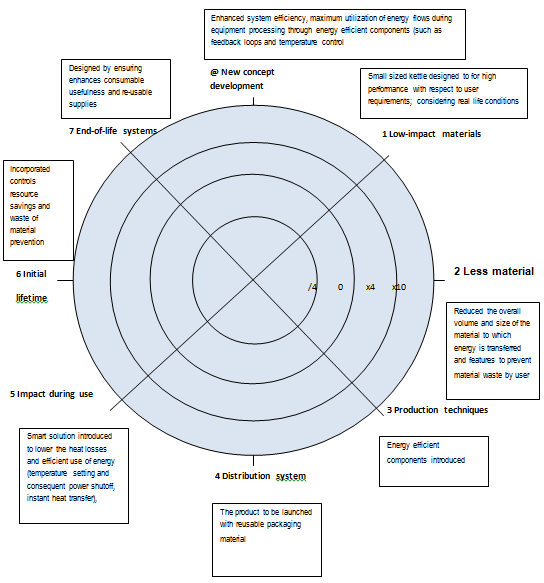
In a survey conducted by students of the Department of Mechanical Engineering in The University of Texas USA, in 2009, it was estimated that 0.83 Kg of water was consumed daily by most household kettle users, with a frequency of 8 times a week, in four-year life span. Therefore this data was used to estimate the amount of energy consumption/saved. Required data to assess a complete LCA was unavailable; such as product manufacturing details and transportation. Electricity was measured in watts, and the electrical to thermal conversion ratio was assumed to be 100%. Energy losses through steam were the total
Total energy saved was calculated by the equation. Heat losses are calculated for overheating between 16 seconds to 70 seconds as examples, and do not illustrate the actual figures.
Average consumption of water = 0.86 x 8 x 4 x 12 x 4 = 1274 kg in four years of life span. For each Kg of water, total Electrical energy input for Barun at 1360 watts (66 sec overheating) is 482 kJ, Compressor at 1340 watts (16 sec overheating) is 400 kJ and for Proctor Silex at 930 watts (70 sec overheating) is 422 kJ. Therefore average energy consumption is 434 kJ. Estimated savings percentage for each additiothe n of control system was calculated and given in table 2
Figure 4: General description of energy flow

Conclusion
As it can be seen from the table above, an shut-off of the kettle resulted in environmental impact reduction. The product Life cycle was undisturbed in other aspects. Installation of other control equipment as described above can lead to reduced environmental impacts. If the user tunes the kettle at the low set point that is 76 degrees C, avoids unwanted usage, much of the energy can be saved. However additional control may lead to environmental contamination in terms of waste effects during manufacturing and extra disposals. Additional energy, material and chemical may also be used during manufacturing of the materials. In short, this design can guarantee much higher efficiency and environmental benefits when used correctly by the users.
References
Karna, A. 2002. Environmentally Oriented product design: A Guide for Companies in the Electrical and Electronics Industry, revised edition, pp. 36-41.
Lagerstedt, J. & Luttrop, C., 2006. Eco Design and the Ten Golden Rules: Generic Advice for Merging environmental aspects into product development," Journal of Cleaner Production, 14, pp. 1395-1407.
Reap, J., Duncan, S., Roman, F. & Bras, B., 2008. A Survey of Unresolved Problems in Life Cycle Assessment, Part 2; Impact Assessment and Interpretation. International Journal of Life Cycle Assessment, pp. 373-389.
Sherwin, C., 2012, Sustainable behaviour by design, Guardian sustainable business [online] Available at: < http://www.guardian.co.uk/sustainable-business/blog/sustainable-behaviour-design-toolkit> [Accessed 24 February 2013].
Skerlos, S. J., Michalek, J. J. & Morrow, W. R., 2006. Sustainable Design Engineering and Science: Selected Challenges & Case Studies. Sustainability Science and Engineering, Volume-1.
Telenko, C., Seepersad, C. & Webber, M., 2009. A method for Developing Design for Environment Guidelines for Future Product Design, Department of Mechanical Engineering, University of Texas, Austin, USA, pp.2-11
Tomlinson, J. J. & Durfee, D. J., 2001. Boston Washer Study, Department of Energy.
Wood, K. L. & Otto, K. N., 1998. Product Evolution: A Reverse Engineering and Redesign Methodology, Research in Engineering Design, pp. 227-242.
Zimmerman, J. B., McDonough, W., Anastas, P. T., & Braungart, M.,
- Applying the Principles of Green Engineering to Cradle to Cradle Design, Environmental Science & Technology, pp. 434.A-441.A.
Get 3+ Free Dissertation Topics within 24 hours?

















